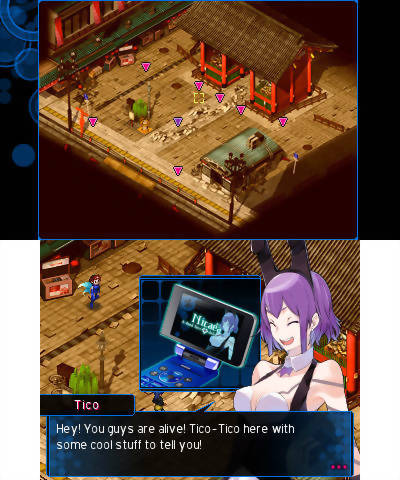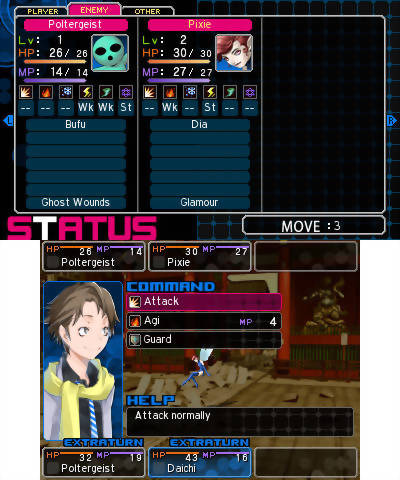
The Fittest Survivor
Atlus’s Megami Tensei franchise dates back to the 1980s, when Namco published early installments, with North American gamers receiving no exposure to the series thanks in part to the moral guardians’ sensitivity towards even the slightest religious overtimes in videogames, largely seen as a hobby geared towards younger audiences. Fortunately, the gaming industry would somewhat loosen in this aspect, with early MegaTen titles such as the first Persona seeing English release, although Atlus hadn’t quite refined their localizations, the North American PlayStation release of that particular game attempting often poorly to mask its Japanese origins.
It wasn’t until the foreign release of the third mainline Shin Megami Tensei title, subtitled Nocturne, that the franchise would achieve its contemporary following outside Japan, and since then, most entries of the series has seen English releases. The MegaTen series would grow to include dozens of spinoffs with varying game mechanics, among them being the Devil Survivor subseries, the franchise’s take on turn-based tactics, sort of spiritual successors to the untranslated Majin Tensei series that were strategy RPGs as well. Both games in the spinoff series would see initial release and localization on the Nintendo DS, but then see enhanced rereleases on the 3DS, the second being Shin Megami Tensei: Devil Survivor 2 Record Breaker.
The first and only Devil Survivor’s sequel’s port follows completely different characters from its predecessor, still occurring in Japan, among them being the male protagonist whom the player names and his best friend Daichi, both leaving a mock examination. On their cellular phones, they receive video messages from the website Nicaea, which foretells the death of a friend via a video showing their demise. The hero, Daichi, and their female friend Io become Devil Summoners to battle demons instigating the events, and encounter the organization known as the Japanese Meteorological Agency, specifically its Geomagnetism Research Department, colloquially called JP’s (pronounced “jips”).
Record Breaker features a narrative structure similar to the first game, where the player can select different events from a list during city navigation, each consuming half an hour, with one only able to view a finite number before needing to participate in a story battle necessary to advance the central plot, which contains two primary arcs: The Septentrione Arc, and the Triangulum Arc. The sequel generally tells both stories well, with the countless variations adding plentiful lasting appeal, although the latter portion of the plot has some derivative elements such as amnesia. The translation is largely free of error, and ultimately, the narrative is a chief draw to the game.

Like how great this game is.
Fortunately, solid gameplay backs the experience, with Record Breaker mechanically similar to the first game, being devoid of random encounters, with fights instead occurring as the player wills. As in Overclocked, there are two main modes of combat: free battles, from which the player can withdraw anytime if they aren’t succeeding whilst keeping experience acquired for characters and demons, not to mention “cracked” skills (with this particular system working much as it did in the first game), and storyline battles, from which the player can’t retreat. Free battles always have the objective to eliminate all enemy demons, with a data chip sometimes present letting one of the collecting character’s demons to learn a grayed-out skill, giving a new assignable ability, or extra money.
One major improvement over Overclocked is that collecting these treasure chips doesn’t cause the game to crash occasionally, and another facet that helps reduce wasted time in storyline battles is that on the casual difficulty, Blessed, losing one of said engagements allows the player to restart with all experience and cracked skills retained, which can definitely be a blessing in that certain fights may have more skills than the player’s four battling teams are able to learn. Another addition to the sequel is the Fate system, with all acquirable party members having up to five levels that may advance when viewing a cutscene focused on one particular character.
Advancing one Fate level provides a character one or two natural elemental resistances that reduces the need to equip passive skills that provide them, two the ability to “joint skill crack” with the protagonist who can consequentially to acquire a skill for the party when defeating an enemy targeted by the ally, three an additional fusible demon, four the ability to send an assigned demon to the hero in the middle of battle, and the maximum of five another potential demonic fusion. The system of combining demons to create more powerful incarnations works much the same as in Overclocked, players mercifully allowed manual selection of bequeathed abilities, and able to register fusions in a compendium for future retrieval at a price.
The other main method of acquiring new demons is the auction, with paid membership level advancement sporadically offered throughout both quests. Sometimes when purchasing demons via auctions, specials occur where the player can obtain other demons for lower prices than usual. As in the first game, the player assigns three HP or MP-consuming abilities, three passive skills, and one auto skill that activates for the party when triggering skirmishes, to each of the human characters, each who can have two demons in their respective teams, up to four participating in any mode of combat. When starting a battle, the player can scan the battlefield and its foes, and set their characters’ starting positions, though they aren’t always critical to victory.
Once a battle begins, the player’s characters and the enemy teams take their turns depending upon agility, with a turn order meter, expected of any turn-based RPG, luckily showing who takes their turns when. Whenever one of the player’s teams reaches their turn, the player can move them around a given range, use skills such as healing spells or demon race abilities to perform tasks such as reducing an adversarial team’s movement range to one when they reach their turn, one per unit in a turn. If enemies are still out of range, the player can simply end one of their team’s turns, but when in range, the player can initiate a skirmish that takes them to a separate combat screen.
When a skirmish begins, the player inputs commands for the leader and his/her two demons, with both sides’ units exchanging commands depending upon agility, with some foresight thus being necessary as in most traditional turn-based RPGs classic and modern. If a unit on either side exploits their opponents’ weaknesses, they receive an extra turn allowing the player to execute another command for all units who have acquired them, with no retribution from the enemy unless they’ve also gained supplementary turns. The death of the leader of either opposing team, or each side failing to eliminate the other in their respective turns, ends the skirmish, with experience and money rewarded, the former proportional to a character or demon’s level and the latter dependent upon how well the player performed.
Story battles sometimes have special objectives such as preventing certain NPCs from dying, which are luckily fair most of the time, especially on Blessed difficulty. Sometimes after a skirmish, moreover, the player may acquire a skillset bonus that they can use on a prospective fused demon to unlock grayed-out skills that the player has cracked from combat. All in all, the game mechanics work superbly, with most fights rarely dragging out, and the different difficulty settings are sure to attract players of divergent skill. Pretty much the only real hiccup is the aforementioned issue with turn order during skirmishes, although Record Breaker definitely demonstrates that Atlus learned from whatever mistakes they made in the first Devil Survivor.

The refined strategic gameplay of Overclocked, minus the suck of freezes.
Devil Survivor 2 is very easily one of the most user-friendly strategy RPGs in the history of its subgenre, with crystal-clear direction on how to advance the central storyline, given the relative linearity, easy menus, the aforementioned ability to choose skills for fused demons manually unlike the roulette system in olden MegaTen titles, an accurate in-game clock, the suspend save, and especially the fact that it doesn’t crash like its predecessor’s updated rerelease. Pretty much the only major issue is the slight tedium of assigning and changing the active and passive abilities of the player’s characters, but otherwise, control leaves little room for improvement.
SaGa composer Kenji Ito and series regular Shoji Meguro collaborated on the soundtrack, and the results are predictably solid, with most of the battle themes bearing Ito’s catchy, signature style, Meguro’s electrical pieces being just as good. Record Breaker also adds voicework during cutscenes, with all voices fitting the characters and generally being tolerable, and while there are some shrill performances, the player can almost always cut short the voiced dialogue, so the game really doesn’t force the acting down their throat. Ultimately, the sound helps the game far more than hurts.
The same goes for the visuals, which, while largely similar to those in the first game, definitely have more going for them than against them. The human character and demon designs are superb, with the former showing a wide spectrum of emotion during cutscenes, and no reskins whatsoever among the latter. The battlefield graphics also look nice, with photorealistic 2-D prerendered environments and character/enemy sprites containing good anatomy, the former having nice animation and effects such as flipping open their cellphones. The various 3-D elements on the bottom screen are smooth and fluid, the top screen interface using the 3DS’s three-dimensional capabilities well. Pretty much the only real issue is the inanimation of foes during skirmishes, although the attack and ability effects look nice, and Record Breaker is far from an eyesore.
Finally, the port will last players a fair amount of time, as little as two days total for a straightforward playthrough of the main quest, although one can potentially spend up to four days with the second quest tacked on, with plentiful lasting appeal in achievements and the New Game+ where the player can purchase things to bequeath into either campaign from the start.
In summation, one can adequately describe Devil Survivor 2 Record Breaker with many phrases: a fun RPG, a vastly-improved sequel, a more-than-functional port, a bucket list game, a title accessible to players of most skill levels, one of the best Nintendo 3DS games, one of the best strategy roleplaying games, one of the best entries of a storied franchise that has its share of good and bad installments, a modern masterpiece; the list can continue endlessly. In my lifetime as a gamer, I never thought that a tactical RPG, which I consider least-favorite roleplaying game subgenre, would turn out to be one of my all-time favorite games. It’s incredibly difficult not to recommend this game, and I sincerely hope others have the same positive experience I did, should they choose to play it.
This review is based on a playthrough of a digital copy purchased by the reviewer through both main storyline campaigns.
The Good:
+Refined tactical gameplay with adjustable difficulty.
+Very tight control, with no bugs or freezes.
+Great storyline with some variations.
+Localization doesn’t mask Japanese setting.
+Excellent soundtrack and voicework.
+Superb artistic direction.
+Plenty reasons to come back for more.
The Bad:
-Skirmishes sometimes require foresight.
-Slightly-derivative story elements.
-A few shrill voices.
-Some recycled graphics from the first game.
The Bottom Line:
One of the best entries of a series that has its share of good and bad installments.
Score Breakdown:
Platform: Nintendo 3DS
Game Mechanics: 9.5/10
Controls: 9.5/10
Story: 9.5/10
Localization: 9.5/10
Music/Sound: 9.5/10
Graphics: 9.5/10
Lasting Appeal: 10/10
Difficulty: Adjustable
Playing Time: 2-4 Days
Overall: 10/10
No comments:
Post a Comment